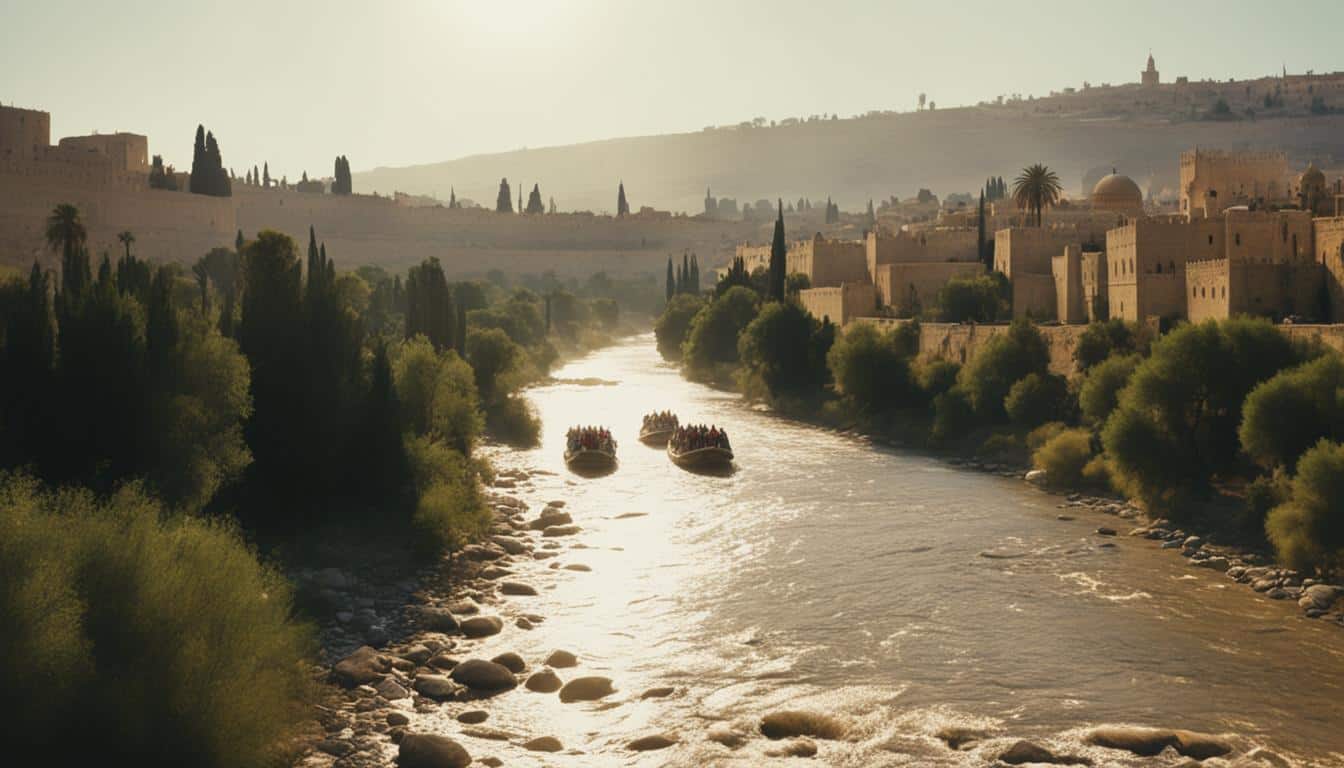Table of Contents
Have you ever thought about what a pilgrimage to Zion in ancient times was like?
Imagine walking the same paths and experiencing the awe-inspiring journey to Jerusalem that many believers undertook.
Get ready for a captivating exploration of the pilgrimage to Zion. We will dive into the historical and spiritual aspects of this journey to Jerusalem.
Envision dusty roads leading to the majestic city. Imagine pilgrims from all corners of the ancient world coming together. There’s a sense of anticipation in the air.
To understand this pilgrimage, we must grasp the allure of Zion. It is the beckoning call to Jerusalem that has echoed throughout history. Let’s start an enlightening exploration of Zion’s significance and why the call to Jerusalem captivated hearts across generations.
But why is the pilgrimage to Jerusalem spiritually significant?
This physical journey symbolizes our spiritual journey towards God. Let’s uncover the deep symbolism of the pilgrimage to Jerusalem. We will explore lessons to understand our personal connection with the divine.
The journey is filled with songs that ancient pilgrims sang. The Psalms of Ascent are more than melodies; they echo Christ. Let’s discover the hidden messages in these ancient songs. They have profound relevance to our understanding of the pilgrimage to Jerusalem.
Are you ready for a prophetic glimpse into the kingdom of God?
By exploring Isaiah’s vision of Zion, we connect to Christ’s coming. This prophetic insight shapes our understanding of Jerusalem in Revelation. Prepare to see the glory of the new Zion and its eternal significance.
We then delve into Jesus’ earthly ministry and the Triumphal Entry. This moment fulfills the ancient pilgrimage to Jerusalem with profound symbolism. It unveils the true identity and mission of Jesus.
Our journey brings us closer to Jerusalem’s heart, focusing on the Temple. We explore its symbolism and connection to Christ’s role as mediator. Discover how Jesus, the ultimate mediator, fulfills and transcends the Temple’s purpose in Jerusalem.
Finally, we reach the ultimate destination – the New Jerusalem. Journey with us into the vivid descriptions of this heavenly city in Revelation. As we illustrate the new Zion, we deepen our understanding of Christ’s eternal kingdom and our role within it.
The Mount of Olives invites us to explore its role in Jesus’ ministry and prophecies. Learn how these prophecies enhance our view of Jesus as the Messiah.
Jerusalem’s history is rich with feasts and festivals. They celebrate God’s salvation history and offer insights into Jesus’ redemptive work. Join us in exploring the significance of these celebrations and their link to Christ.
Yet, tragedy struck when Jerusalem fell. In those dark moments, hope emerged. Lamentations express sorrow while promises of restoration ignite hope. Let’s explore these themes of lamentation and hope, discovering their significance in Christ’s redemptive work.
On this sacred journey, our spiritual pilgrimage mirrors the ancient journey to Jerusalem. Walking with Jesus and embracing past lessons, we head towards our ultimate destination – the New Jerusalem. Join this captivating exploration of faith and revelation, where ancient and eternal meet.
The Call to Jerusalem: Understanding the Significance of Zion
In biblical history, Jerusalem is more than a city. It’s a spiritual hub, drawing believers worldwide to its sacred grounds. This call to Jerusalem touches the hearts of the faithful. It brings them closer to God and deepens their religious practices.
Zion, another name for Jerusalem, is crucial in religious traditions. It’s highlighted in the Old Testament and other texts. The call to Jerusalem is an invite to feel God’s connection with humanity. It lets people see His plan in action.
Throughout history, Zion represents where God resides. It stands for divine favor, protection, and salvation. Zion is a spiritual retreat for believers to find peace, worship, and connect with the divine.
Going to Jerusalem shows one’s faith and dedication. It’s a pilgrimage of worship and commitment. This journey answers Jerusalem’s call, allowing believers to partake in ancient religious practices.
For years, pilgrims have traveled to Jerusalem for spiritual awakening. They pray at the Western Wall, follow the Via Dolorosa, and visit the Church of the Holy Sepulchre. Zion’s importance is in how it transforms those who visit.
“…for out of Zion shall go forth the law, and the word of the Lord from Jerusalem.” – Isaiah 2:3
Jerusalem is a beacon of light in biblical prophecy. It’s where God’s word spreads and His laws are followed. The journey to Jerusalem is both a physical and spiritual quest for knowledge and connection with God.
By understanding Zion’s significance, we see its impact on religious practices and beliefs. It challenges us to reflect on our spiritual path. And it encourages us to consider how we can respond to Jerusalem’s call in our lives.
Let’s dive into Jerusalem’s rich history and spiritual essence. May the call to Zion inspire change in us. Next, we’ll explore the symbolic meaning of a pilgrimage to Jerusalem and its reflection of our journey towards God.
How Does the Concept of Pilgrimage to Jerusalem Symbolize Our Spiritual Journey Towards God?
Going to Jerusalem for a pilgrimage is much more than traveling. It’s a deep spiritual journey. It reflects our search for a closer relationship with God. Many faiths see the pilgrimage as significant.
This journey is like our own path to God. It’s about finding ourselves, strengthening our faith, and changing for the better.
Throughout time, people of various cultures and religions have gone to Jerusalem. They go seeking spiritual growth and a stronger connection with God. Just being there is a step of faith and discovery.
“The pilgrimage to Jerusalem is an expression of our longing to draw nearer to God, to seek spiritual enlightenment, and to grow in our understanding of divine grace.” – Unknown
The journey can be hard, filled with challenges. It mirrors the spiritual hurdles we face. These test our faith and dedication to growing spiritually.
Yet, this pilgrimage teaches us valuable lessons. It shows that our spiritual path may have ups and downs and surprises.
In Jerusalem, we see many faiths and meet people on their spiritual paths. This diversity shows that the search for God is universal.
We learn about letting go and humility. The journey helps us transcend ourselves. We open up to divine guidance and change.
Not everyone can visit Jerusalem. But we can all seek God in our ways. Through prayer, meditation, or kindness, our journey is unique and sacred.
Thinking about the pilgrimage to Jerusalem reminds us: our spiritual journey is ongoing. It needs perseverance, faith, and willingness to follow divine guidance. Let the pilgrimage inspire us to deepen our bond with God.

The Psalms of Ascent: Echoes of Christ in the Pilgrim’s Songs
On their way to Jerusalem, pilgrims sang the Psalms of Ascent. This collection of fifteen psalms showed their hope, love, and thanks. These psalms weren’t just about their trip to the holy city. They also had a deeper meaning, showing ties to Christ.
The Psalms of Ascent were sung as people went up to Jerusalem to pray at the temple. These songs were more than just background music for their journey. They guided the worshipers’ hearts, pointing them to God.
“I was glad when they said unto me, Let us go into the house of the LORD.”
– Psalm 122:1
These psalms are filled with hints of Jesus Christ. Just like the pilgrims went to Jerusalem, Jesus did too, completing God’s salvation plan.
In the Psalms of Ascent, we see reflections of Christ’s work and His sacrifice. For instance, Psalm 121 shows Jesus as our protector:
“I will lift up mine eyes unto the hills, from whence cometh my help. My help cometh from the LORD, which made heaven and earth.”
– Psalm 121:1-2
These words show Jesus as our constant helper and savior. The Psalms of Ascent let us peek into Jesus’ purpose, uplifting us.
When we look at these ancient songs, let’s find Christ in them. They give us hope and understanding, enriching our faith journey.
| Psalms | Themes |
|---|---|
| Psalm 120 | The pilgrim’s cry for deliverance |
| Psalm 121 | God’s protection and help |
| Psalm 122 | Longing for the house of the Lord |
| Psalm 123 | Waiting on the Lord |
| Psalm 124 | Gratitude for God’s deliverance |
| Psalm 125 | Trusting in the Lord’s protection |
| Psalm 126 | Harvest of joy and restoration |
| Psalm 127 | The Lord’s blessing on the home |
| Psalm 128 | Blessings of fearing the Lord |
| Psalm 129 | Triumph over oppression |
| Psalm 130 | Cry for forgiveness and redemption |
| Psalm 131 | Childlike trust in the Lord |
| Psalm 132 | God’s faithfulness to David |
| Psalm 133 | Unity among God’s people |
| Psalm 134 | Call to worship and praise |
Isaiah’s Vision of Zion: A Prophetic Glimpse into the Kingdom of God
Isaiah showed us a deep and spiritual look into Jerusalem’s future glory. This is tied to Christ’s coming. He shows us God’s kingdom’s final achievement, highlighting the divine plan and future restoration.
This vision is rich in vivid images and beautiful language. It shows the grand beauty of Zion. It gives believers hope, making them look forward to God’s eternal kingdom.
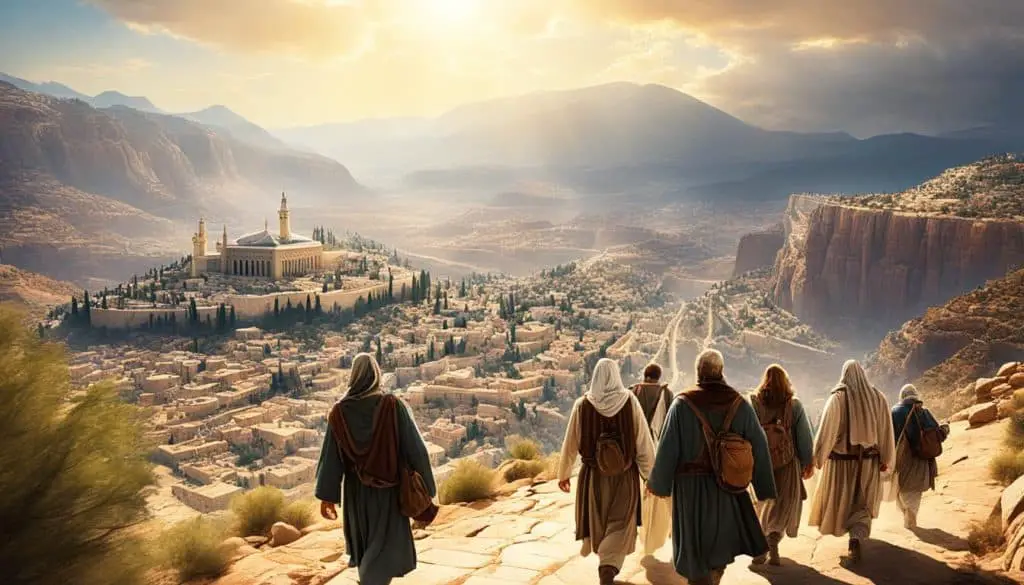
Isaiah saw a future where Jerusalem shines brighter than any nation. It’s filled with God’s presence and is a hub for worship. His vision includes the city’s physical and spiritual renewal.
“For out of Zion shall go forth the law, and the word of the Lord from Jerusalem.” – Isaiah 2:3
The vision points to the Messiah, who brings hope and righteousness to Zion. Jesus Christ is the key to this prophecy. He shared the kingdom’s good news and started saving us all.
Through Isaiah’s vision, we understand God’s plan for redemption. It gives us hope in Christ and a bright future for believers.
The Prophetic Nature of Isaiah’s Vision
Isaiah’s picture of Zion is more than just a physical place. It’s a peek into the spiritual essence of God’s kingdom. This kingdom is rich in righteousness, peace, and joy.
He foresaw a time of fairness and unity. Nations would seek God’s wisdom and follow His path. This vision shows the global impact of God’s kingdom and His wish for everyone to feel His love.
“And the glory of the Lord shall be revealed, and all flesh shall see it together: for the mouth of the Lord hath spoken it.” – Isaiah 40:5
This vision of Zion offers us hope for renewal and restoration. It tells believers to keep faith, assuring that God’s kingdom will win against darkness.
The Kingdom of God: A Journey of Hope
Isaiah’s vision reminds us that God’s kingdom is both a future promise and a current reality in believer’s hearts. It invites us to join in God’s kingdom work on earth now.
By following Isaiah’s vision and living by God’s purposes, we spread love, justice, and kindness. Our journey towards God’s kingdom is filled with hope, inspired by Isaiah’s prophecy.
References:
- Book of Isaiah, King James Version (KJV)
Jesus’ Triumphal Entry: Fulfilling the Pilgrimage to Jerusalem
The journey to Jerusalem is a sacred path, filled with spiritual meaning. It is about getting closer to our faith. Jesus’ arrival in Jerusalem was remarkable, standing out as a deeply symbolic event.
This event was huge, marking the end of His work and his final trip to Jerusalem. As He entered the city on a donkey, people cheered, seeing Him as the Messiah they awaited.
Riding on a donkey, a sign of peace, showed Jesus’ peaceful mission. It showed His humility and followed God’s plan. This act completed the sacred journey He and so many took.
“Blessed is the King who comes in the name of the Lord!”
John 12:13 (KJV)
The crowd’s cheers linked Jesus’ arrival to old pilgrimage songs. They saw Him as the King prophecy spoke of. Their cheers showed a deep bond between Jesus’ entrance and age-old journeys of faith.
Jesus’ entry was also a bold message of who He was. It revealed His divine rule and questioned the era’s religious leaders. With this, Jesus openly took His place as the awaited Messiah, ready to start God’s Kingdom on Earth.
Jesus’ entry into Jerusalem has lasting importance for our faith. It invites us to begin our own spiritual journey with God. Following Jesus means adopting His humility and peace. It’s about acknowledging Him as our savior and building a personal bond.
On this spiritual journey, we’re called to live as Jesus did. We recognize Jesus as our King, promising salvation and eternal life. Through this relationship, our lives change, and we help bring God’s Kingdom to life here on Earth.
Jesus’ triumphant entry is a powerful reminder of our spiritual journey. It’s about walking in faith and living out God’s plan for us. Let’s be inspired by His example as we move toward our heavenly home.
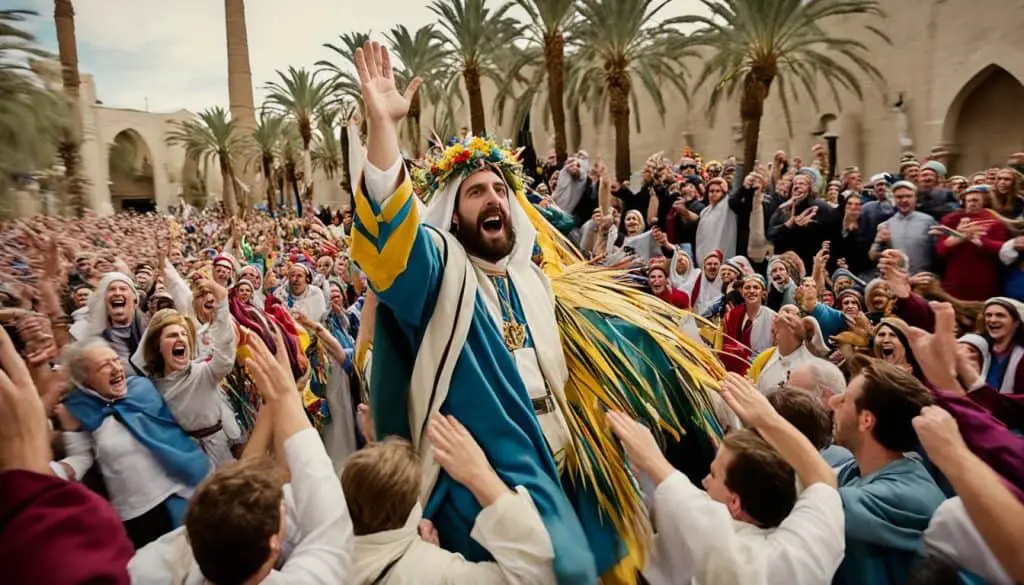
The Temple in Jerusalem: A Type of Christ’s Mediatorial Role
The temple in ancient Jerusalem was more than just a building. It was where God lived among His people. It was where people worshipped, sacrificed, and met with God.
The temple showed us a hint of Jesus Christ’s role. While the temple connected God and His people, Jesus did even more. He became the bridge between God and all of humanity.
Like the temple was for sacrifice, Jesus was the ultimate sacrifice. He took the world’s sins upon Himself. Because of His sacrifice, anyone who believes in Him is saved forever.
“For there is one God, and one mediator between God and men, the man Christ Jesus” (1 Timothy 2:5, KJV).
The temple was where God’s glory was felt. Similarly, Jesus brought God’s glory to us by becoming human. We don’t need a building to feel God’s presence anymore. Through Jesus, God’s Spirit is in us.
Jesus called Himself the temple, pointing towards His death and resurrection. This made a lasting bond between God and people.
Jesus is now our focus of worship. He connects us to God. In Him, we find a deep relationship with the Father.
| Symbolism of the Temple in Jerusalem | Christ’s Mediatorial Role |
|---|---|
| Sacred space of divine presence | Jesus as the embodiment of God’s presence |
| Place of sacrifice and atonement | Jesus as the ultimate sacrificial offering |
| Dwelling place of God’s glory | Jesus as the fullness of God’s glory |
| Object of worship | Jesus as the true object of worship |
Jerusalem in Revelation: The New Zion as Christ’s Eternal Kingdom
The book of Revelation shows Jerusalem as the new Zion, symbolizing Christ’s everlasting reign. These sections are filled with strong imagery and symbols. They show where Christ’s followers aim to end up.
The new Jerusalem shines bright, reflecting God’s glory. There’s no need for the sun or moon here. The Lord’s light brightens everything, showing the eternal nature of Christ’s kingdom. Here, His divine light and life are all that matter.
This holy city is a place of unmatched peace and joy. Its walls, decorated with precious stones, show God’s greatness. The pearl gates symbolize purity and the entrance to the King’s realm.
“And I saw a new heaven and a new earth: for the first heaven and the first earth were passed away… And I John saw the holy city, new Jerusalem, coming down from God out of heaven… And she had a wall great and high, and had twelve gates… And the building of the wall of it was of jasper: and the city was pure gold, like unto clear glass… And the twelve gates were twelve pearls: every several gate was of one pearl.”
The new Jerusalem’s descriptions show the eternal glory of Christ’s kingdom. It’s a place for righteousness and endless communion with God.
This vision of the new Jerusalem gives believers hope for what’s ahead. We’re reminded that our real home is yet to come. A future in God’s presence is what awaits us.
Like ancient pilgrims journeying to Jerusalem, we long for our spiritual journey’s destination in the new Zion. Our faith grows, helping us face life’s challenges, as we look forward to our future with God.
In conclusion, Revelation’s glimpse of the new Jerusalem inspires us. It pushes us to seek a deeper relationship with our Savior. And it fills us with hope for the marvelous future in His presence.
References:
- Revelation 21:1-3
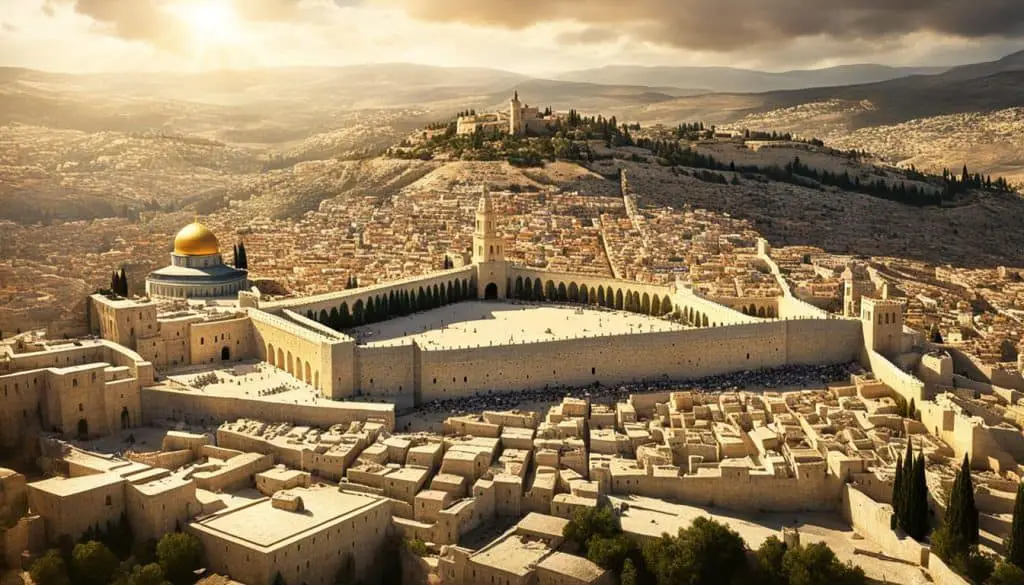
The Mount of Olives: A Place of Departure and Return
To the east of Jerusalem sits the Mount of Olives. It’s a key site in Jesus’ ministry, holding deep future prophecies. Unlike any other, this sacred place touches important moments in Jesus’ life, showing us who He is as the Messiah.
Jesus often retreated to the Mount of Olives when in Jerusalem. It was His quiet place for prayer and thinking. His life was full of powerful teachings and miracles. Yet, it was often to the Mount of Olives where His path started and ended.
This place is crucial in prophecies about the end times. Jesus talked about future happenings here. In Matthew 24, in a talk called the “Olivet Discourse,” He discussed His return and the end of days. His words from the Mount give us a glimpse into what’s ahead, highlighting its importance in God’s plan.
“And as he sat upon the mount of Olives, the disciples came unto him privately, saying, Tell us, when shall these things be? and what shall be the sign of thy coming, and of the end of the world?” – Matthew 24:3 (KJV)
Jesus shared many prophecies on the Mount of Olives. He spoke of the signs of His return, times of trouble, and His reign on Earth. These teachings are both warnings and comforts. They urge us to stay alert and faithful.
The Mount of Olives is also where Jesus spent His last hours before the crucifixion. In the Garden of Gethsemane, He prayed deeply, accepting God’s will. This moment connects the Mount closely to Jesus’ sacrifice for us all.
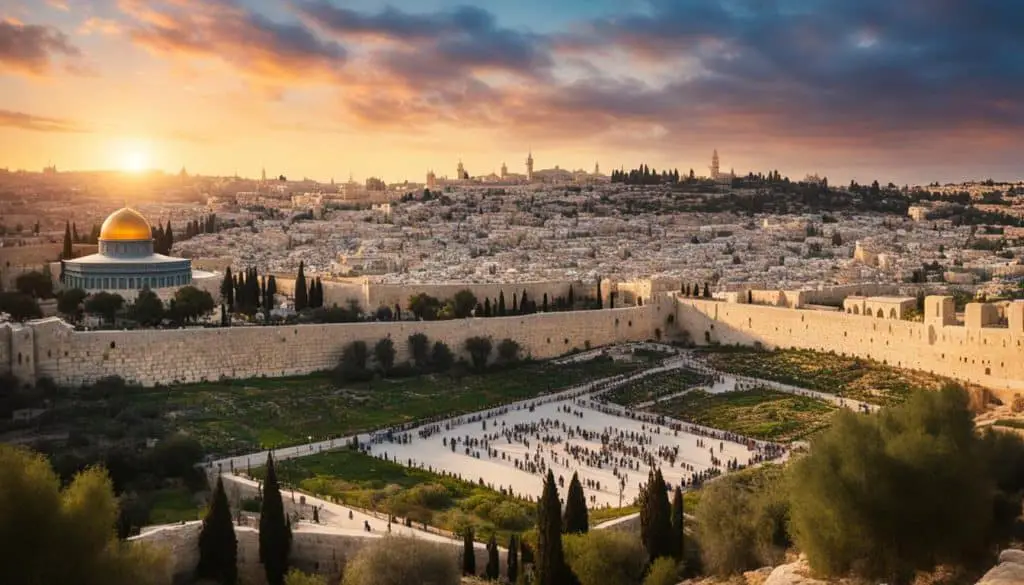
Looking into the Mount of Olives shows us more about Jesus and His mission. It reminds us of His departure and the promise of His return. This sacred spot signals God’s redemption plan and His kingdom’s coming.
Feasts and Festivals: Celebrating God’s Salvation History
The people of God, the Israelites, held feasts and festivals in Jerusalem. They did this to remember and honor God’s acts of saving them. These events were key to their culture and faith, reminding them of God’s help and rescue over time.
The Passover was a major feast that remembered the Israelites’ freedom from Egypt. Families would come to Jerusalem to sacrifice and share a special meal, including the Passover lamb. This celebration was not just about the past. It also looked forward to Jesus Christ, who brings salvation to everyone.
The Feast of Weeks, or Pentecost, was another big celebration. It remembered when Moses received the Law and celebrated the harvest. People from everywhere would bring their offerings and thank God for His gifts. For Christians, this feast is special too. It was during this time that the Holy Spirit came to the first followers of Jesus, helping them share the good news.
“Let us keep the feast, not with old leaven, neither with the leaven of malice and wickedness; but with the unleavened bread of sincerity and truth.” – 1 Corinthians 5:8
The Feast of Tabernacles (Sukkot) was also significant. It remembered the Israelites’ time in the wilderness, living under God’s care. People would build temporary shelters and stay in them for seven days, celebrating and offering sacrifices. This time pointed to a future when God would live among His people forever.
These feasts and festivals were more than just traditions for Jerusalem. They were full of meaning and helped people understand God’s plan of salvation. They all pointed to Jesus Christ, who is the reason for hope and redemption for everyone.
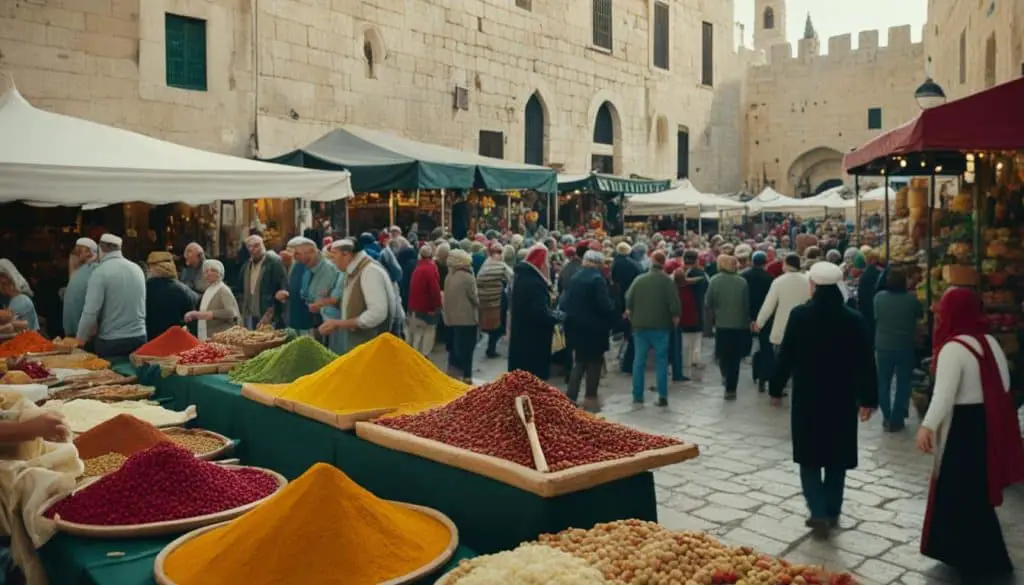
| Feasts and Festivals | Significance |
|---|---|
| Passover | Commemoration of God’s deliverance from slavery in Egypt and foreshadowing of Jesus Christ. |
| Feast of Weeks (Pentecost) | Celebration of the giving of the Law to Moses and the empowering of the Holy Spirit for the spread of the gospel. |
| Feast of Tabernacles (Sukkot) | Commemoration of the Israelites’ time in the wilderness and representation of the future dwelling of God with His people. |
These celebrations were crucial to the spiritual life in Jerusalem and still mean a lot to Christians today. They remind us of God’s loyalty, His saving actions, and our hope in Jesus Christ. He is the key to God’s plan of saving the world.
Lamentations and Hope: Jerusalem’s Fall and the Promise of Restoration
After Jerusalem fell and its holy sites were destroyed, the book of Lamentations shares the deep sorrow felt. It shows the ruin and heartbreak of the people vividly. Despite the destruction, there’s still a spark of hope for rebuilding.
The book tells of the deep sadness Jeremiah and Israel felt losing Jerusalem. It reminds us of their disobedience’s cost and Jerusalem’s tragic downfall.
“How doth the city sit solitary, that was full of people! How is she become as a widow! She that was great among the nations, and princess among the provinces, how is she become tributary! She weepeth sore in the night, and her tears are on her cheeks: among all her lovers she hath none to comfort her: all her friends have dealt treacherously with her, they are become her enemies.” – Lamentations 1:1-2
Yet, in Lamentations, hope shines through the sorrow. It shares a promise of renewal amidst the darkness. This hope speaks of God’s unchanging love and faithfulness to His people.
Lamentations offers words of God’s kindness and the possibility of coming back from despair. These words encourage us that there is always light and renewal with God, even in the darkest times.
“It is of the Lord’s mercies that we are not consumed, because his compassions fail not. They are new every morning: great is thy faithfulness.” – Lamentations 3:22-23
The promise of coming back is not just about the city’s physical rebuild. It also points to a deeper healing found in Jesus Christ, the Messiah. In Him, we find the chance for a fresh start and recovery of everything lost.
Like Jerusalem went through tough times, we might also face difficulties and sadness. But in Jesus Christ, there is a promise of healing and renewal for us. He gives us hope and mends our broken pieces.
Thinking about the sorrow and hope, let’s cling to the restoration promise. God’s faithfulness gives us comfort. Even through tough times, we can trust God to use our challenges for our benefit and His honor.
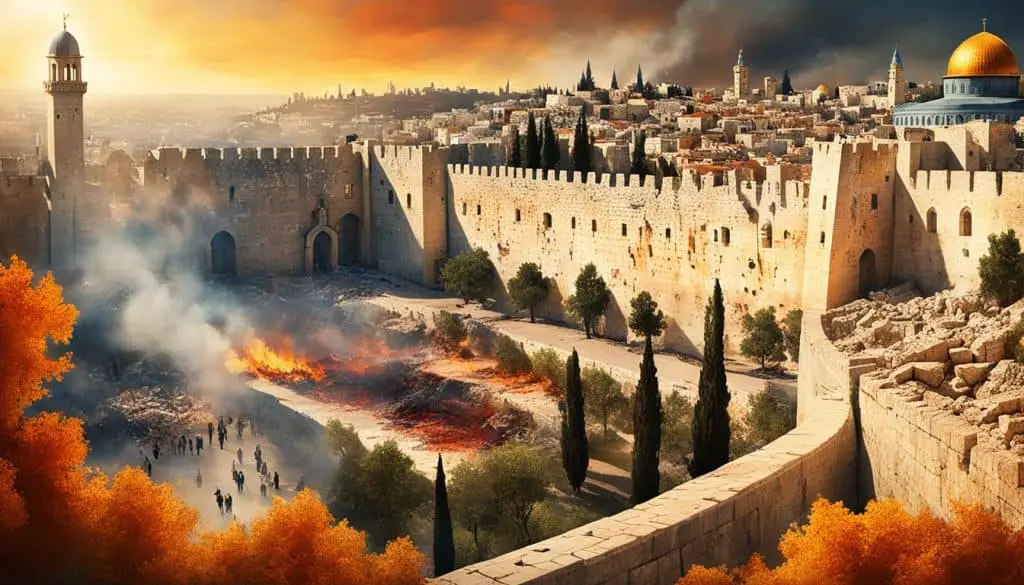
| Lamentations | Hope | Jerusalem’s Fall | Promise of Restoration |
|---|---|---|---|
| Describes the grief and lamentations over Jerusalem’s destruction | Offers hope amidst the despair | Reflects on the consequences of disobedience | Promises the restoration of Jerusalem |
| Emphasizes the desolation and despair | Points to God’s faithfulness and enduring love | Speaks of the devastation and loss | Reminds us of the ultimate restoration in Christ |
How Did the Ancient Pilgrimage to Zion Influence Later Jewish Thought?
The ancient pilgrimage to Zion had a profound impact on later Jewish thought, solidifying Zion’s significance in Judaism. The journey to the holy city fostered a deep connection to the land and a sense of unity among the Jewish people. This pilgrimage continues to be a source of inspiration and spiritual significance for Jews worldwide.
The Journey of Faith: Walking with Jesus to Our New Jerusalem
Our faith journey is like the old trips to Jerusalem. We walk with Jesus to the new Jerusalem, our final home. This journey deepens our bond with Jesus and grows our faith.
Walking with Jesus means we follow His teachings and live like He did. We give ourselves to His plan. On this path, we change through His love, grace, and forgiveness. Getting closer to Jesus, we connect with the true meaning of Jerusalem. That it’s a preview of our forever home with Him.
Our journey of faith has hard times, just like it did for the pilgrims back then. But with Jesus leading us, we keep hope. The promise of a new Jerusalem gives us strength. The ancient city of Jerusalem was a sign of hope. The new Jerusalem is God’s promise to all who trust in Jesus.
Let’s keep moving forward with Jesus towards our new home. Let our hearts wait excitedly, our steps lit by His light. In this journey, we find true happiness and peace with Christ. He is our Savior and the goal of our pilgrimage.

